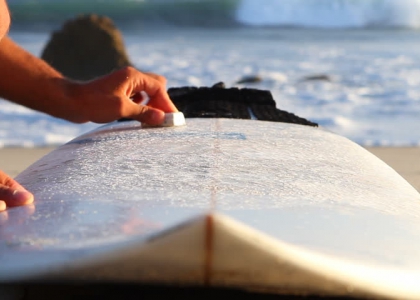How to wax a surfboard properly?

The wax on your surfboard is one of the most important things in surfing because it gives you and your feet a firm grip when standing on the board.
So it's especially important that you properly grow your board before you hit the water.
Different Types of Surf-Wax
There are also different types of wax and these in turn for different water temperatures.
One distinguishes the wax once in base coat and normal surf wax. The so-called base coat is a slightly stronger tougher wax, which is used as the first adhesive layer or base layer. Only on the thin layer Base-Coat comes the right surf wax on top.
Why should i use a base coat?
By using a base coat, the normal wax keeps better and longer especially on the board and it can create more beautiful "bumps" (waxy hills). So with a base coat, you'll have something of your wax job for longer.
Which wax is suitable for which water temperatures?
The waxy varieties are optimized for the different water temperatures and differ in terms of heat resistance, consistency and stickiness. Each pack of surf wax shows exactly what water temperatures the wax is suitable for.
A distinction is generally made under the following common standard names:
Cold - For particularly cold waters, e.g. the North and Baltic Sea in winter
Cool - For cool waters such as North and Baltic Sea in autumn and spring, or Atlantic in winter
Warm - For slightly warm waters such as Atlantic Ocean in midsummer
Tropical - Only suitable for tropical and very warm waters as in Indonesia, Hawaii, Caribbean Islands, etc.
IMPORTANT: Please choose only ecologically friendly surf wax!
Please do yourself and the environment a favor and buy only so-called "eco-surf wax" (eco-friendly surf-wax). These new natural compounds do not harm the environment or the waters and are in no way inferior to the "chemical" surf wax varieties. On the contrary, they are sometimes even stickier and "stickier" than the traditional / old surf wax varieties that are not made of natural ingredients.
How to apply the wax to your surfboard?
Everyone usually grows their board a bit differently and in their own unique way. That's why I want to show you my very own proven method here, how to easily get a great layer of wax with great bumps (waxy hills).
- Take a conventional base-coat and rub it all over as a thin base layer on the areas of your surfboard deck where you want the wax and the grip. Remember that you will be "gas" with the front foot also a little bit further forward and thus there also need the grip and the wax layer.
- If you have applied the base coat on your board, now the normal surf wax, also called top coat, is used. There are two different good techniques that you can try out.
Diamond pattern: Here you draw a check pattern on the bace coat layer with the normal surf wax. Pull the long lines diagonally of the surfboard with a sharp corner of the wax-brocken and then the opposite cross-lines. All lines are best only with an intermediate distance of about 1 - 1.5 cm to each other. The more often you follow these longitudinal and transverse lines, the more beautiful Wax Hills you will get.
Circular motions: You take now the normal surf wax and rub it with the narrower side edge in uniform circular movements directly on the base coat layer on the board. The more you draw and repeat the circles over and over again, the more and larger of the desired wax hillocks you will get.
My personal favorite is a combination of these two variants. First, i put on a thin basecoat layer all over, then do further with the top coat and the diamond pattern as described above and then after this i wax it again with medium-sized circular movements over all the diamond pattern. As a result, you get a really good wax job and nicer larger wax bumps will arise.


